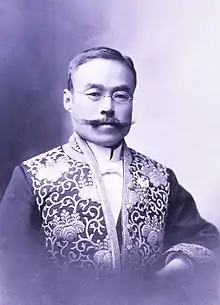Manabu Miyoshi
Manabu Miyoshi (三好 学, Miyoshi Manabu, January 4, 1861 – May 11, 1939) was a Japanese botanist. The standard author abbreviation Miyoshi is used to indicate this person as the author when citing a botanical name.[1]
Manabu Miyoshi | |
|---|---|
 M. Miyoshi, between 1895 and 1923 | |
| Born | December 2, 1874 |
| Died | May 11, 1939 (aged 78) |
| Resting place | Tama Cemetery |
| Nationality | Japanese |
| Alma mater | Imperial University of Tokyo University of Leipzig |
| Scientific career | |
| Fields | Botany |
| Institutions | Imperial University of Tokyo |
| Doctoral advisor | Wilhelm Friedrich Philipp Pfeffer |
| Author abbrev. (botany) | Miyoshi |
Biography
Miyoshi was born in 1861 in the village of Iwamura, now part of modern-day Ena. He was born in a samurai family from the former province of Mino. A graduate of the Imperial University of Tokyo in 1889, he continued his scientific training at the University of Leipzig under the direction of German botanist Wilhelm Friedrich Philipp Pfeffer. In 1895, he earned his Doctorate of Science degree and returned to Japan as Professor of Botany at the University of Tokyo.[2]
He entered the Imperial Academy of Japan in 1920.
Throughout his academic career, he studied the genera Prunus and Iris. At the beginning of 20th century, he promoted the idea of ‘natural monuments’ for preservation, a concept he brought back with him from his period of study in Germany.[3]
Awards
- 1917: Order of the Sacred Treasure, 2nd class.
Selected publications
- Miyoshi, Manuba, ed. (1905–1914). Atlas of Japanese Vegetation: Phototype Reproductions of Photographs of Wild and Cultivated Plants as Well as the Plant-Landscapes of Japan, with Explanatory Text. Tokyo: The Maruzen Kabushiki Kaisha (Z.P. Maruya & Co., Ltd.). 15 sets.